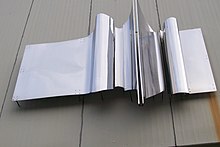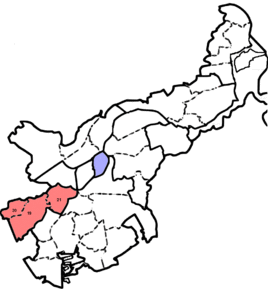Lübeck-Moisling
|
Moisling
City of Lübeck
Coordinates: 53 ° 50 ′ 28 " N , 10 ° 37 ′ 57" E
|
|
|---|---|
| Height : | 11 m |
| Area code : | 0451 |
|
Location of the Moisling district in Lübeck with the numbers of the city districts
|
|

Moisling is a district of the Hanseatic city of Lübeck . It includes the city districts of Niendorf / Moorgarten (19), Reecke (20) and Alt-Moisling / Genin (21).
The place name Moisling goes back to a family name. A von Moisling (Moycelinghe) family owned an estate on the outskirts of the city, which the Lübeck councilor Hermann von Osenbrügge bought in 1376.
Location and traffic
The Moisling district is located between the Trave and the Elbe-Lübeck Canal, which flows into it, in the southwest of the city and borders the Duchy of Lauenburg and Stormarn . It lies on the Lübeck – Hamburg railway line , where the new Lübeck-Moisling stop will be built in the future . Moisling is cut through by the A 20 . A tunnel in which the A 20 under the Niendorfer Strasse or Niendorfer Hauptstrasse forms the border between the districts of Moisling and Niendorf. The district itself has no direct motorway connection. The Motorway access Luebeck-Moisling to A 1 located in the district Lübeck-Buntekuh .
The district of Alt-Moisling / Genin has a large number of apartment blocks. The six towers (The Six-Pack) of the residential high-rises in the southeast are very dominant. The Moislinger Aue recreational area also belongs to the city district. A good 10,000 of the 11,600 residents of the district live in the district. There is also an outdoor swimming pool and the Jewish cemetery on Niendorfer Straße . Gut Moisling, which gave the district its name, was demolished in 1970. In its place today stands the house for everyone called Moslinger Mitte at a busy confluence . Günter Ferdinand Ris created their wall sculpture , after he had already participated in documenta II , documenta III and the Biennale di Venezia , in 1970 as art in architecture . The stainless steel work of art was financed by the Possehl Foundation .
The city district of Alt-Molisling / Genin is bordered in the southwest by the city district of Niendorf and Moorgarten , which is larger in terms of area but has only around 1,400 inhabitants. In this almost village-like district, single-family houses dominate, most of which were built along Niendorfer Hauptstrasse and a few parallel streets. The manor house Niendorf (Weißenrode Castle) is also located on Niendorfer Hauptstrasse. Moorgarten used to be the location of the mounted police in Lübeck. The district of Reecke is a small village in the northwest of the district with about 100 inhabitants.
The Brandenmühle is located south of the A 20 on the boundary with Oberbüssau.
history
Village and Gut Moisling were first mentioned together with Niendorf and Reecke in 1265 as the property of Conrad and Friedrich von Moislingen. Since 1372 it belonged to various Lübeck residents, including the mayor Hieronymus Lüneburg and the Lübeck patrician family Höveln . Since it was in the Duchy of Holstein , sovereignty over the area was a cause for dispute several times. Gotthard von Höveln , owner of the estate since 1646, promoted it by settling craftsmen right at the gates of Lübeck who competed with the city's offices . In 1667 he resigned from the council in the dispute over the Lübeck constitutional reform ( cash process ) and placed Moisling under Danish protection. Only in 1802 did Lübeck acquire Moisling, Niendorf and Reecke back.
The first Jews were among those who settled in Moisling by Gotthard von Höveln in 1656. They fled Poland after the Khmelnytskyi uprising and were not granted a right of residence in Lübeck. The first synagogue in today's area of the city of Lübeck has been located here since 1727 . The Jewish cemetery in Moisling , where u. a. members of the Lübeck rabbi family Carlebach are also buried, still exists today. After the Jewish community in Lübeck was destroyed by the Holocaust, the enclosed cemetery was not used until the Lübeck Jewish community grew through immigration since the 1990s and new graves were laid on the edge of the old grave areas. In the “Moislinger Friedhof” a memorial plaque and tombstones remind of 38 unknown Jews who died in connection with the bombing of the Cap Arcona .
schools
Number of pupils from the school year 2017/2018
-
Elementary schools
- Mühlenweg School, Moislinger Mühlenweg, 188 students in 9 classes
- Elementary school-Lübeck-Niendorf, Niendorfer Hauptstraße, 46 students in 2 classes
-
Elementary and community schools
- Heinrich Mann elementary and community school, Brüder-Grimm-Ring, 500 students in 27 classes
-
Support centers
- Astrid-Lindgren-Schule - the largest support center in Schleswig-Holstein with special educational focus on learning, language and emotional and social development, Brothers-Grimm-Ring 6–8 (founded in 1985 as Strakerjahn School in St. Lorenz), 49 students in the 5th Classes, total of 599 supervised
-
Former schools
- School Moisling, elementary school with the end of secondary school, August-Bebel-Straße, (closed in 2010)
church
-
Evangelical Lutheran
- Wichernkirche, Andersenring
-
Roman Catholic
- St. Francis Church, Kiwittredder
Cultural monuments
literature
- Peter Guttkuhn: Half a ton of beer for every paddock that is tied up. 1806 - 2006: 200 years of the Lübeck village and Gut Moisling . In: Lübeckische Blätter: Journal of the Society for the Promotion of Charitable Activities . tape 171 , 2006, ISSN 0344-5216 , p. 165-169 .
- Peter Guttkuhn: The History of the Jews in Moisling and Lübeck: From the Beginnings in 1656 to Emancipation in 1852 . Second improved edition. Schmidt-Römhild, Lübeck 2007, ISBN 978-3-7950-0486-6 .
See also: Jews in Moisling and Lübeck
Web links
- Moisling History a project by the district and the school
- District profile 2003 - Lübeck-Moisling
- Map of the city districts and districts with a topographical background
- Goebelonline: Moisling: Maps, hereditary estates, city property, pottery, school
Individual evidence
- ↑ Nah.SH is planning seven new train stations , In: kn-online.de. August 2, 2018, accessed April 10, 2020.
- ↑ from: Topography and Statistics of Lübeck and the Hamburg joint office of Bergedorf from 1856
- ↑ Plaque in the jury's court room of the Burgkloster cultural forum in Lübeck. Image from the Schreiber archive.
- ↑ Statistical Office for Hamburg and Schleswig-Holstein: Directory of general education schools in Schleswig-Holstein 2017/2018





